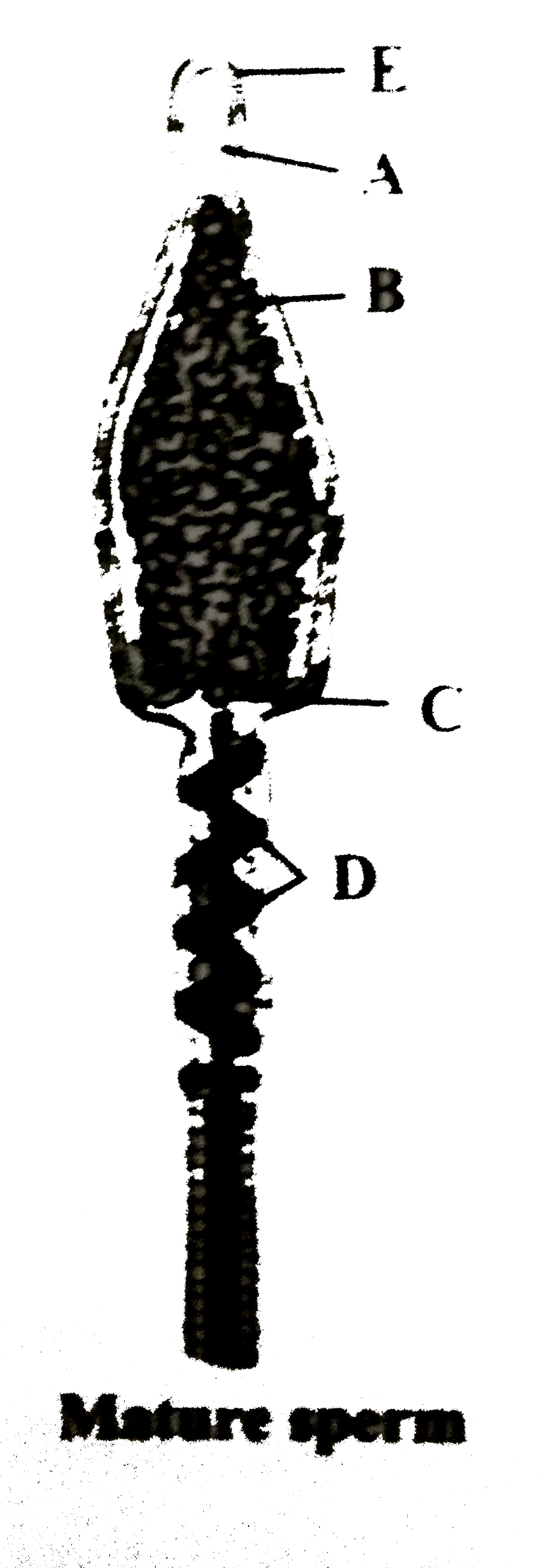Draw a schematic diagram of a human sperm and label the cellular components.
Step-by-Step Text Solution:
1. Draw the Outline of the Sperm: Start by drawing a streamlined shape to represent the human sperm. The sperm consists of three main parts: the head, middle piece, and tail.
2. Label the Head:
- In the head section, draw a small cap-like structure at the top. This is the acrosome.
- Below the acrosome, draw a larger oval shape to represent the nucleus. The nucleus contains the genetic material (DNA) of the sperm.
3. Label the Middle Piece:
- Below the head, draw a cylindrical section to represent the middle piece.
- Inside this section, draw spiral shapes to indicate the presence of mitochondria. These mitochondria are responsible for providing energy for the sperm's movement.
4. Label the Tail:
- Extend a long, whip-like structure from the middle piece to represent the tail.
- Indicate that the tail is covered by a plasma membrane which aids in the motility of the sperm.
5. Add Functions:
- Next to the acrosome, write that it contains hydrolyzing enzymes that help dissolve the egg membrane during fertilization.
- Next to the mitochondria, note that they provide energy for sperm movement.
- Next to the tail, mention that it aids in the motility of the sperm, allowing it to swim in a liquid medium.
6. Final Touches: Ensure all components are clearly labeled and that the diagram is neat and organized.
- In the head section, draw a small cap-like structure at the top. This is the acrosome.
- Below the acrosome, draw a larger oval shape to represent the nucleus. The nucleus contains the genetic material (DNA) of the sperm.
- Below the head, draw a cylindrical section to represent the middle piece.
- Inside this section, draw spiral shapes to indicate the presence of mitochondria. These mitochondria are responsible for providing energy for the sperm's movement.
- Extend a long, whip-like structure from the middle piece to represent the tail.
- Indicate that the tail is covered by a plasma membrane which aids in the motility of the sperm.
- Next to the acrosome, write that it contains hydrolyzing enzymes that help dissolve the egg membrane during fertilization.
- Next to the mitochondria, note that they provide energy for sperm movement.
- Next to the tail, mention that it aids in the motility of the sperm, allowing it to swim in a liquid medium.
Topper's Solved these Questions
- REPRODUCTIONBOOK - TRUEMEN BIOLOGY ENGLISHCHAPTER - REPRODUCTIONEXERCISE - SECTION -C
22 Videos
- Protista BOOK - TRUEMEN BIOLOGY ENGLISHCHAPTER - Protista EXERCISE - ASSERTION AND REASON
6 Videos
- Reproduction In OrganismsBOOK - TRUEMEN BIOLOGY ENGLISHCHAPTER - Reproduction In OrganismsEXERCISE - MULTIPLE CHOICE QUESTION
131 Videos
Similar Questions
Knowledge Check
Identify the parts labelled as A, B, C, D and E in the given diagram of a human sperm and select the correct option.
 AA-Nucleus, B-Tail, C-Mitochondria,
AA-Nucleus, B-Tail, C-Mitochondria,
D-Acrosome, E-CentrioleBA-Acrosome, B-Nucleus,
C-Centriole, D-Mitochondria,
E-Plasma membraneCA-Nucleus, B-Mitochondria,
C-Plasma membrane,
D-Centriole, E-NeckDA-Acrosome, B-Centriole,
C-Mitochondria, B-Centriole,
C-Mitochondria, D-Plasma membrane, E-Tail
Draw a labelled diagram of human ovum.
View SolutionDraw a diagram of human eye and ear and label their various parts
View SolutionDraw the well labelled diagram of a mature human sperm and label its parts.
View SolutionDraw a labelled diagram of a neuron.
View SolutionDraw a labelled diagram of a nephron.
View SolutionDraw a diagram of mature human sperm . Label any three parts and write their function .
View SolutionDraw a labeled diagram of sperm.
View Solution
